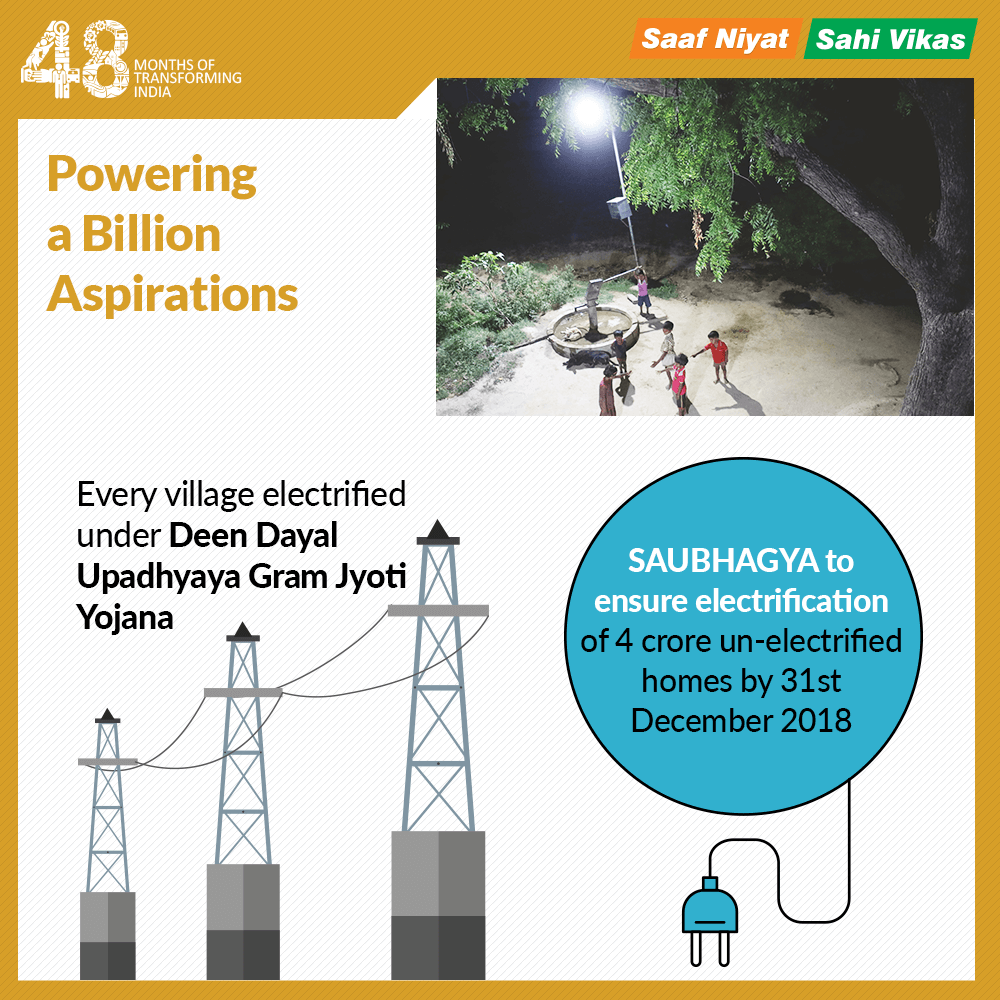[orc]How true are the government claims about electrification of villages & households? Here is a fact check
In an infographic titled powering a billion aspirations, the government made two claims about electrification. The claims talk about two schemes: Deen Dayal Upadhyaya Gram Jyoti Yojana and Saubhagya Scheme. Here is a fact check of these claims.

Has every village been electrified under the DDUGJY?
The first claim is that every village has been electrified under the Deendayal Upadhyaya Gram Jyoti Yojana (DDUGJY). The DDUGJY was launched by the current government replacing the Rajiv Gandhi Grameen Vidyutikaran Yojana (RGGVY) which was launched by the UPA in 2005.
The definition of an electrified village has been changing with time. Prior to 1997, a village was classified as electrified if electricity is being used within its revenue area for any purpose whatsoever. After 1997, this definition was modified to the extent that if electricity is used in the inhabited locality, within the revenue boundary of the village for any purpose whatsoever, the village would be deemed electrified.
The current definition of an electrified village has been in vogue since February 2004. As per this definition, a village is considered electrified if
- Basic infrastructure such as distribution transformer and distribution lines are provided in the inhabited locality as well as the Dalit Basti hamlet where it exists.
- Electricity is provided to public places like Schools, Panchayat Office, Health Centers, Dispensaries, Community centers etc.
- The number of households electrified should be at least 10% of the total number of households in the village.
As per the annual reports of the Rural Electrification Corporation, the government company in charge of the electrification of villages, the current government electrified more than 18000 un-electrified villages during its term. And as per an answer provided in the Lok Sabha, all inhabited census villages have been electrified by April 2018. Rural electrification became a priority issue with the launch of the RGGVY in 2005 by the UPA government. During its term, the UPA government electrified more than a lakh villages. It also has to be noted that the current government electrified some of the most difficult villages in terms of access & terrain. During the last two years of the UPA, the number of villages electrified had reduced while it again increased in 2015-16 and 2016-17.
One of the other goals of DDUGJY is intensive electrification of villages (providing electricity connections to more households). The progress report of the DDUGJY, released in September 2018, states that while the total scope of the intensive electrification program was 780337 villages, the achievement is 548875 villages.
Claim: Every village has been electrified under Deen Dayal Upadhyaya Gram Jyoti Yojana.
Fact: While all inhabited villages as per the census were electrified by April 2018, this is not an achievement of the current government alone and not under the DDUGJY. Hence, the claim is MISLEADING.
What about Saubhagya Scheme?
The second claim is that Saubhagya scheme is to ensure electrification of 4 crore un-electrified homes by 31st December 2018. Government of India launched the Pradhan Mantri Sahaj Bijli Har Ghar Yojana (Saubhagya) in September 2017 with an outlay of Rs. 16,320 crore including budgetary support of Rs. 12,320 crore from Government of India. The objective of the scheme is to provide last mile connectivity and electricity connections to all households in rural and urban areas across the country.
Under the Saubhagya scheme, free of cost electricity connections would be provided to all remaining un-electrified households with at least one deprivation criteria on the basis of Socio Economic Caste Census (SECC) data in rural areas and economically poor households in urban areas. Others would be charged a sum of Rs. 500 per household which shall be recovered by the respective State Distribution utility/Power Department in ten equal installments along with the electricity bill.
According to an answer provided by the government in Lok Sabha, 101.56 lakh households have been given electricity connections as of August 2018 since launch of Saubhagya scheme. The latest number as per the Saubhagya dashboard is 180.51 lakh households.
Claim: Saubhagya to ensure electrification of 4 crore un-electrified homes by 31st December 2018.
Fact: The scheme has been launched in 2017 with the aim of electrifying 4 crore households. Since this claim talks about a future target, we will only know in December 2018 whether 4 crore un-electrified households have been electrified. Hence the claim remains UNVERIFIED.
This story is part of a larger series on the 4-years of the Modi government. This series has been made possible with the flash grant of the International Fact Checking Network (IFCN). Read the rest of the stories in this series here.


